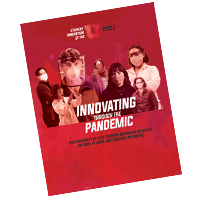At the start of the pandemic, the Utah Symphony | Utah Opera was gearing up for their performance season. As rising coronavirus case counts threatened to close their doors, they needed expertise that could keep the performers and audience safe. Luckily, the search landed on a team of music lovers that included students at the U and was led by assistant professors of chemical engineering Tony Saad and James Sutherland.
The challenge? Find a way to limit the spread of droplets from wind and brass instruments without damaging the integrity of the performance. If that wasn’t difficult enough, the duo had a time limit — just 10 weeks.
Saad and Sutherland sized up the problem. With the help of Josh McConnell, a postdoc candidate, and two Ph.D. students, Hayden Hedworth and Mokbel Karam, they jumped on board.
“COVID-19 has been hard on everyone,” Karam said. “We knew it would be stressful work, but the idea that we could make this time even a little less difficult for our community was really rewarding.”
In the following months, the team approached the dispersion problem through a series of models. Focusing on the aerosolized respiratory droplets emitted from the instruments, they followed the airflow. They became very familiar with Abravanel Hall’s HVAC system, dedicating hours to taking measurements, making guesses, running simulations, reviewing results, and going back to square one.
After a grueling process of trial and error, they found a solution: combined with opening the side doors, rearranging the seats of brass and wind instruments significantly reduced the spread of droplets, and, ultimately, the risk of infection.
More articles like this in ‘Student Innovation @ the U!’
Find this article and a lot more in the 2021 “Student Innovation @ the U” report. The publication is presented by the Lassonde Entrepreneur Institute to celebrate student innovators, change-makers, and entrepreneurs.




